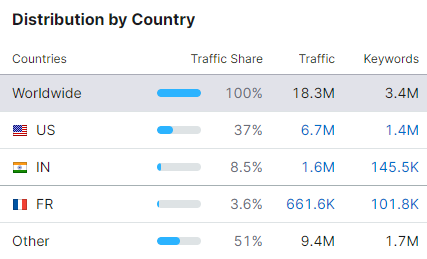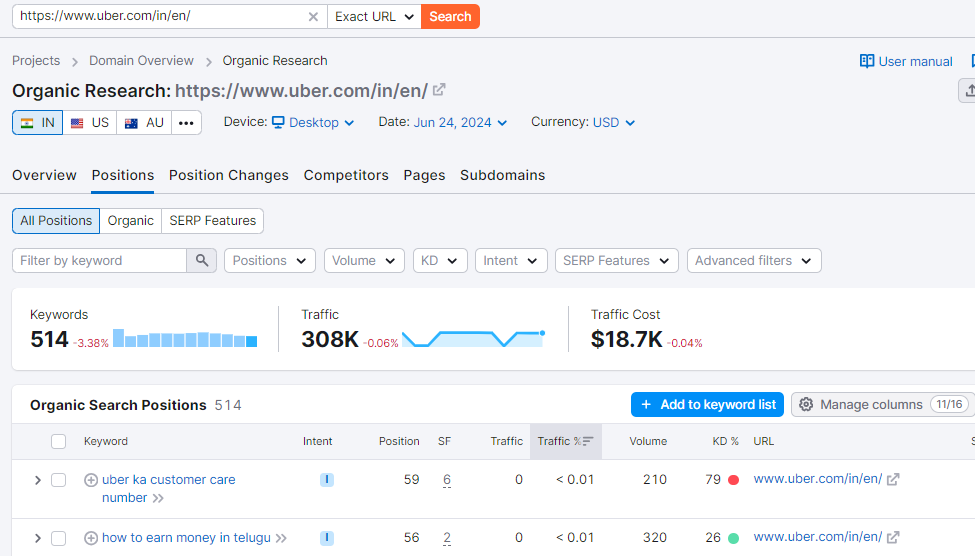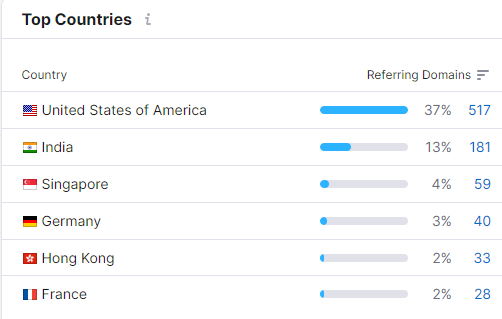Brief Overview of Uber
From a simple ride-hailing app in San Francisco to a global powerhouse operating in over 95 countries, Uber’s story is one of remarkable growth and innovation. Founded in 2009, Uber revolutionised transportation by connecting users with drivers through their smartphones.
Its user-friendly interface, transparency in fares and real-time tracking, safety features, and competitive pricing have propelled Uber to become the world’s largest ride-hailing company. But Uber’s ambition extends beyond rides.
Recognising the potential of on-demand services, it expanded into food delivery (Uber Eats) and logistics (Uber Freight), catering to a broader customer base.
Despite facing regulatory issues and labour disputes, Uber’s focus on technology, convenience, and global expansion positions it as a dominant force in the transportation and delivery sectors, poised to shape the future of how people and goods move worldwide.
Why Uber Needed International SEO
While Uber was a dominant force in the US market, international expansion necessitated a strong international SEO strategy. Here’s why:
Increased Visibility: International SEO helps Uber rank higher in search results for relevant keywords in different countries. This increases brand awareness and attracts new users who might not be familiar with the app.
Local Market Penetration: International SEO allows Uber to tailor its content and approach to specific regions. This includes optimising for local languages, regulations, and user preferences, leading to a more effective market penetration strategy.
App Downloads and Rides: By ranking higher in local searches, Uber can drive more app downloads and, ultimately, more ride bookings.
Segregation of Country Share behind Uber International SEO strategy
By segmenting its approach based on country share, Uber can effectively allocate resources and tailor its SEO strategy to each market’s unique needs and growth potential.
High Traffic: Focus on maintaining top ranking in established markets with a large user base (e.g., USA, India, Brazil). This might involve ongoing keyword research, content optimisation, and strong local link building.
Growing Traffic: Implement strategies to increase market share in countries with a growing user base (e.g., Mexico, Indonesia, South Africa). This could involve localised marketing campaigns, influencer partnerships, and SEO targeting local keywords.
New Markets: Develop strategies to enter new markets with lower initial traffic (e.g., emerging economies in Southeast Asia or Africa). This might involve building brand awareness, partnerships with local transportation companies, and SEO focused on local language and ride-hailing terminology.
How Uber Implemented International SEO
Understanding Uber’s international SEO strategy requires looking beyond just the provided key markets. Uber adapts its mobile application’s content, advertisement appeals, and design to reflect the targeted markets’ language, culture, and relevant legislation.
This might involve using local currencies, payment methods, and ride options catering to specific needs (e.g., motorbikes in Southeast Asia).
Uber Key Markets
Uber likely conducts extensive market research to identify high-potential regions based on factors like internet penetration, smartphone usage, and ride-hailing demand.
Technical SEO
Uber ensures a secure connection with HTTPS across all markets, protecting user data. This is a standard practice that boosts user trust and search engine rankings. Here’s a breakdown of how Uber might be implementing technical SEO for its international strategy:
Hreflang Tags
Uber effectively employs hreflang tags to indicate the language and regional variations of its website content. This helps search engines serve users the correct language version, improving the user experience and search engine optimisation.
URL Structure
Uber utilizes a combination of subfolders and ccTLDs (country-code top-level domains) to target specific countries. For example, www.uber.com/ca/en/ for Canada and www.uber.com/fr/fr/ for France. This strategy aids local SEO, as search engines can easily identify the intended audience for each variation.
| Country | URL Structure |
| US | www.uber.com/us/en |
| Canada | www.uber.com/ca/en/ |
| France | www.uber.com/fr/fr/ |
| India | www.uber.com/in/en |
Content Localization
Uber’s commitment to content localisation is evident in its seamless adaptation to various languages and cultural nuances.
They ensure accurate translations and culturally sensitive content, demonstrating a deep understanding of their diverse user base. By conducting thorough market research, Uber tailors its messaging, imagery, and app interface to resonate with local audiences.
Compliance with local regulations and data privacy standards is also a key focus, fostering trust and reliability. Additionally, Uber likely leverages user-generated content, such as reviews and ratings in local languages, to further enhance its global strategy and connect with users deeper.
This comprehensive approach to content localisation strengthens Uber’s global presence and improves user engagement across diverse markets.
Accurate Translation
Uber ensures accurate translations across its platforms, providing a consistent and reliable user experience. To this end, it likely employs professional translation services or a dedicated in-house team.
By avoiding literal translations that may lead to confusion or cultural insensitivity, Uber demonstrates a commitment to its global user base.
Localised Keywords
Uber’s content localisation strategy extends to keyword optimisation. They conduct thorough keyword research for each target market, identifying terms and phrases that users in those regions are likely to search for.
By incorporating localised keywords, Uber ensures its content appears in relevant local search results. This increases visibility and improves the app’s discoverability among target audiences.
The company likely utilises translation tools and local market insights to identify the most effective keywords, adapting them to match the language nuances of each market.
Localised Content
Uber’s localised content strategy is a pivotal aspect of its global success. The company ensures that its content, including the app, website, and marketing materials, is translated into various languages, providing a seamless and accessible experience for users worldwide.
Beyond translation, Uber adapts its content to align with each market’s cultural nuances and user preferences. This may involve tailoring imagery, references, or the app’s interface to resonate with local audiences.
By conducting thorough market research and understanding cultural sensitivities, Uber creates relevant and engaging content that speaks directly to its diverse user base, fostering a sense of familiarity and trust. This localised content strategy helps Uber connect with users on a deeper level and enhances its overall global presence.
Traffic Numbers by Countries
Uber’s traffic performance varies across these selected countries. The US market has the highest traffic volume, boasting 6.7 million visitors. This is followed by India, which attracts 1.6 million users to Uber’s platform.
Canada and France also demonstrate significant traffic numbers, with 845,500 and 661,600 visitors, respectively. These figures highlight the effectiveness of Uber’s SEO strategies in reaching a broad audience in these markets.
| Country | Traffic | Subfolders |
| US | 6.7M | www.uber.com/us/en |
| Canada | 845.5K | www.uber.com/ca/en/ |
| France | 661.6K | www.uber.com/fr/fr/ |
| India | 1.6M | www.uber.com/in/en |
Keywords Numbers by Countries
Regarding keyword performance, the US market leads again, with a remarkable 1.4 million keywords associated with Uber’s online presence. Canada, France, and India show proportionately lower yet substantial keyword numbers, with 210,400, 101,800, and 145,500 keywords, respectively.
This indicates that Uber’s SEO strategies, including localised content and effective keyword optimisation, drive visibility and search engine rankings in these markets.
| Country | Keywords | Subfolders |
| US | 1.4M | www.uber.com/us/en |
| Canada | 210.4K | www.uber.com/ca/en/ |
| France | 101.8K | www.uber.com/fr/fr/ |
| India | 145.5K | www.uber.com/in/en |
Backlink Profile for Local Language Content/Subfolder
Uber’s backlink profile for the Indian subfolder (https://www.uber.com/in/en/) showcases a strategic focus on local relevance and authority:
Local Link Building: Uber prioritises backlinks from reputable Indian websites, demonstrating a commitment to the local market. These links likely include partnerships with local businesses, collaborations with Indian influencers or media outlets, and listings on popular Indian online directories.
Internal Linking: Uber also effectively employs internal linking to leverage the power of its global domain. Strategic linking from its main website (www.uber.com) and other country-specific subfolders strengthens the authority of the Indian subfolder.
Relevant Anchor Texts: By using relevant and localised anchor texts, Uber ensures that backlinks provide context and improve user experience. This may include variations of “Uber India,” “Ride with Uber,” or localised keywords related to ride-sharing in Hindi or other regional languages.
Diverse Backlink Sources: Uber’s backlink profile for the Indian subfolder likely comprises diverse sources, including news outlets, travel blogs, local business directories, and influencer websites. This diversity reinforces the subfolder’s authority and reach within the Indian market.
Continuous Backlink Acquisition: Uber continuously works towards acquiring new and relevant backlinks. This involves ongoing local partnerships, collaborations, and content creation, ensuring the Indian subfolder maintains and improves its search engine rankings.
Root Domain: https://www.uber.com/in/en/
Top Backlinks for Subfolder
Using subfolders in Uber’s URL structure (e.g., /us/en, /ca/en/, /fr/fr/) plays a crucial role in organising content for different countries.
This structure helps search engines understand the intended audience for each variation, improving local search engine rankings.
Uber can effectively target users in these regions by employing country-specific subfolders, contributing to the high traffic numbers observed.
Top Countries for Backlinks
- The two major countries for backlinks are the US and India
- The US country is targeted for the subfolder’s India-based English Language Pages, while India Country is targeted for Indian-based English Language
- Uber strategically targets the US market to generate backlinks for its Indian-based English language pages. This approach leverages the high authority and influence of the US digital landscape.
- Targeted marketing campaigns in these regions could have resulted in more backlinks from those countries.
- Content that resonates with audiences in specific countries might have attracted backlinks from local websites.
Conclusion
Uber’s international SEO strategy showcases a nuanced understanding of diverse markets, adapting to local languages, search engine preferences, and user behaviours.
Their localised content, strategic URL structure, and effective backlink building have contributed to their global success.
By prioritising cultural sensitivity and market research, Uber connects with users worldwide, enhancing their brand presence and visibility.
At upGrowth, we understand the complexities of navigating international markets. Our growth marketing agency has a diverse team of experts who can help businesses like yours expand globally.
We offer data-driven experiments, comprehensive tracking, and tailored growth consulting. Our unique strategies challenge conventional marketing methods to deliver exponential growth.
Let’s work together to disrupt markets and drive sustainable growth for your business. Contact us to learn how we can elevate your global presence and outperform your competitors.
Watch Now: How Uber International SEO Tactics Drive 18M+ Traffic Globally
Segregation of Country Share behind Uber International SEO strategy
By segmenting its approach based on country share, Uber can effectively allocate resources and tailor its SEO strategy to each market’s unique needs and growth potential.
High Traffic: Focus on maintaining top ranking in established markets with a large user base (e.g., USA, India, Brazil). This might involve ongoing keyword research, content optimisation, and strong local link building.
Growing Traffic: Implement strategies to increase market share in countries with a growing user base (e.g., Mexico, Indonesia, South Africa). This could involve localised marketing campaigns, influencer partnerships, and SEO targeting local keywords.
New Markets: Develop strategies to enter new markets with lower initial traffic (e.g., emerging economies in Southeast Asia or Africa). This might involve building brand awareness, partnerships with local transportation companies, and SEO focused on local language and ride-hailing terminology.
How Uber Implemented International SEO
Understanding Uber’s international SEO strategy requires looking beyond just the provided key markets. Uber adapts its mobile application’s content, advertisement appeals, and design to reflect the targeted markets’ language, culture, and relevant legislation.
This might involve using local currencies, payment methods, and ride options catering to specific needs (e.g., motorbikes in Southeast Asia).
Uber Key Markets
Uber likely conducts extensive market research to identify high-potential regions based on factors like internet penetration, smartphone usage, and ride-hailing demand.
Technical SEO
Uber ensures a secure connection with HTTPS across all markets, protecting user data. This is a standard practice that boosts user trust and search engine rankings. Here’s a breakdown of how Uber might be implementing technical SEO for its international strategy:
Hreflang Tags
Uber effectively employs hreflang tags to indicate the language and regional variations of its website content. This helps search engines serve users the correct language version, improving the user experience and search engine optimisation.
URL Structure
Uber utilizes a combination of subfolders and ccTLDs (country-code top-level domains) to target specific countries. For example, www.uber.com/ca/en/ for Canada and www.uber.com/fr/fr/ for France. This strategy aids local SEO, as search engines can easily identify the intended audience for each variation.
| Country | URL Structure |
| US | www.uber.com/us/en |
| Canada | www.uber.com/ca/en/ |
| France | www.uber.com/fr/fr/ |
| India | www.uber.com/in/en |
Content Localization
Uber’s commitment to content localisation is evident in its seamless adaptation to various languages and cultural nuances.
They ensure accurate translations and culturally sensitive content, demonstrating a deep understanding of their diverse user base. By conducting thorough market research, Uber tailors its messaging, imagery, and app interface to resonate with local audiences.
Compliance with local regulations and data privacy standards is also a key focus, fostering trust and reliability. Additionally, Uber likely leverages user-generated content, such as reviews and ratings in local languages, to further enhance its global strategy and connect with users deeper.
This comprehensive approach to content localisation strengthens Uber’s global presence and improves user engagement across diverse markets.
Accurate Translation
Uber ensures accurate translations across its platforms, providing a consistent and reliable user experience. To this end, it likely employs professional translation services or a dedicated in-house team.
By avoiding literal translations that may lead to confusion or cultural insensitivity, Uber demonstrates a commitment to its global user base.
Localised Keywords
Uber’s content localisation strategy extends to keyword optimisation. They conduct thorough keyword research for each target market, identifying terms and phrases that users in those regions are likely to search for.
By incorporating localised keywords, Uber ensures its content appears in relevant local search results. This increases visibility and improves the app’s discoverability among target audiences.
The company likely utilises translation tools and local market insights to identify the most effective keywords, adapting them to match the language nuances of each market.
Localised Content
Uber’s localised content strategy is a pivotal aspect of its global success. The company ensures that its content, including the app, website, and marketing materials, is translated into various languages, providing a seamless and accessible experience for users worldwide.
Beyond translation, Uber adapts its content to align with each market’s cultural nuances and user preferences. This may involve tailoring imagery, references, or the app’s interface to resonate with local audiences.
By conducting thorough market research and understanding cultural sensitivities, Uber creates relevant and engaging content that speaks directly to its diverse user base, fostering a sense of familiarity and trust. This localised content strategy helps Uber connect with users on a deeper level and enhances its overall global presence.
Traffic Numbers by Countries
Uber’s traffic performance varies across these selected countries. The US market has the highest traffic volume, boasting 6.7 million visitors. This is followed by India, which attracts 1.6 million users to Uber’s platform.
Canada and France also demonstrate significant traffic numbers, with 845,500 and 661,600 visitors, respectively. These figures highlight the effectiveness of Uber’s SEO strategies in reaching a broad audience in these markets.
| Country | Traffic | Subfolders |
| US | 6.7M | www.uber.com/us/en |
| Canada | 845.5K | www.uber.com/ca/en/ |
| France | 661.6K | www.uber.com/fr/fr/ |
| India | 1.6M | www.uber.com/in/en |
Keywords Numbers by Countries
Regarding keyword performance, the US market leads again, with a remarkable 1.4 million keywords associated with Uber’s online presence. Canada, France, and India show proportionately lower yet substantial keyword numbers, with 210,400, 101,800, and 145,500 keywords, respectively.
This indicates that Uber’s SEO strategies, including localised content and effective keyword optimisation, drive visibility and search engine rankings in these markets.
| Country | Keywords | Subfolders |
| US | 1.4M | www.uber.com/us/en |
| Canada | 210.4K | www.uber.com/ca/en/ |
| France | 101.8K | www.uber.com/fr/fr/ |
| India | 145.5K | www.uber.com/in/en |
Backlink Profile for Local Language Content/Subfolder
Uber’s backlink profile for the Indian subfolder (https://www.uber.com/in/en/) showcases a strategic focus on local relevance and authority:
Local Link Building: Uber prioritises backlinks from reputable Indian websites, demonstrating a commitment to the local market. These links likely include partnerships with local businesses, collaborations with Indian influencers or media outlets, and listings on popular Indian online directories.
Internal Linking: Uber also effectively employs internal linking to leverage the power of its global domain. Strategic linking from its main website (www.uber.com) and other country-specific subfolders strengthens the authority of the Indian subfolder.
Relevant Anchor Texts: By using relevant and localised anchor texts, Uber ensures that backlinks provide context and improve user experience. This may include variations of “Uber India,” “Ride with Uber,” or localised keywords related to ride-sharing in Hindi or other regional languages.
Diverse Backlink Sources: Uber’s backlink profile for the Indian subfolder likely comprises diverse sources, including news outlets, travel blogs, local business directories, and influencer websites. This diversity reinforces the subfolder’s authority and reach within the Indian market.
Continuous Backlink Acquisition: Uber continuously works towards acquiring new and relevant backlinks. This involves ongoing local partnerships, collaborations, and content creation, ensuring the Indian subfolder maintains and improves its search engine rankings.
Root Domain: https://www.uber.com/in/en/
Top Backlinks for Subfolder
Using subfolders in Uber’s URL structure (e.g., /us/en, /ca/en/, /fr/fr/) plays a crucial role in organising content for different countries.
This structure helps search engines understand the intended audience for each variation, improving local search engine rankings.
Uber can effectively target users in these regions by employing country-specific subfolders, contributing to the high traffic numbers observed.
Top Countries for Backlinks
- The two major countries for backlinks are the US and India
- The US country is targeted for the subfolder’s India-based English Language Pages, while India Country is targeted for Indian-based English Language
- Uber strategically targets the US market to generate backlinks for its Indian-based English language pages. This approach leverages the high authority and influence of the US digital landscape.
- Targeted marketing campaigns in these regions could have resulted in more backlinks from those countries.
- Content that resonates with audiences in specific countries might have attracted backlinks from local websites.
Conclusion
Uber’s international SEO strategy showcases a nuanced understanding of diverse markets, adapting to local languages, search engine preferences, and user behaviours.
Their localised content, strategic URL structure, and effective backlink building have contributed to their global success.
By prioritising cultural sensitivity and market research, Uber connects with users worldwide, enhancing their brand presence and visibility.
At upGrowth, we understand the complexities of navigating international markets. Our growth marketing agency has a diverse team of experts who can help businesses like yours expand globally.
We offer data-driven experiments, comprehensive tracking, and tailored growth consulting. Our unique strategies challenge conventional marketing methods to deliver exponential growth.
Let’s work together to disrupt markets and drive sustainable growth for your business. Contact us to learn how we can elevate your global presence and outperform your competitors.










